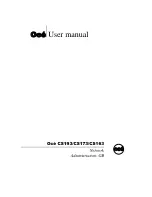
5. Negative/Positive Reversal
The negative/positive reversal circuit executes
the following image processing:
• Negative/positive reversal
• Framing
• Blanking
• Pasting
a. Negative/Positive Reversal
Level conversion is executed so that the white
area of an original will be black and the black area
will be white on copies.
Figure 3-332 (concept of level conversion)
Figure 3-333
b. Framing/Blanking
For framing/blanking, areas may be as many
as 4 areas; for a rectangle, as many as 10 points
may be specified.
■
Framing
The signals representing non-specified areas
are forced to represent white.
Figure 3-334 Framing
■
Blanking
As opposed to framing, the signals represent-
ing the specified area are forced to represent
white.
Figure 3-335 Blanking
e. Pasting
This function may be used when the Retention
Memory Unit (option) is installed. Images stored
in the retention memory in advance and the
image on the copyboard glass are synthesized for
output.
Area
Area
a b c
a b c
(original)
(copy)
Output level
Input level
0 55 128 200 255
255
200
128
55
0
3–47
COPYRIGHT © 1996 CANON INC. CANON GP215/200 REV.0 JULY 1996 PRINTED IN JAPAN (IMPRIME AU JAPON)
3. OPERATIONS AND TIMING


































